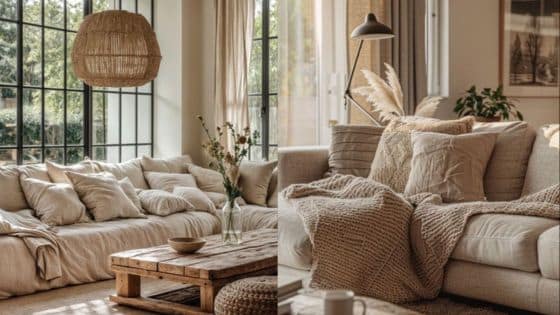Choosing new windows is a significant decision that can impact a home’s comfort, energy use, and long-term costs. Double pane windows use two sheets of glass separated by a spacer and insulating gas, while triple pane windows feature three layers for enhanced insulation. The primary difference between double and triple pane windows is that triple pane options provide greater energy efficiency and noise reduction due to the extra layer of glass and insulation.
For homeowners seeking to reduce energy bills, improve indoor comfort, or block outside noise, understanding the differences between these window types is crucial. Each option comes with its own set of advantages, costs, and practical considerations. Exploring these factors can help determine which window style best fits a household’s needs and climate.

Key Takeaways
- Double and triple pane windows differ mainly by the number of glass layers and their insulation properties.
- Triple pane windows offer better energy savings and noise reduction than double pane and single-pane windows.
- Cost, installation, and specific home needs should guide the choice between window types.
Understanding Double and Triple Pane Windows
Double-pane and triple-pane windows use layers of glass and insulating gas to improve energy efficiency and comfort indoors. The differences in their construction and performance can affect thermal insulation, noise reduction, and cost.
How Double Pane Windows Work
Double-pane windows consist of two sheets of glass, separated by a spacer. This spacer creates an airtight space that is typically filled with an insulating gas, such as argon or krypton. These gases are denser than air, which helps reduce heat transfer.
The edge of each pane is sealed to maintain the gas fill and prevent moisture from entering. Double-pane windows provide much better insulation than single-pane windows, making them a common choice for residential and commercial buildings. Their construction also provides moderate noise reduction. Most double pane glass units strike a balance between performance and affordability.

How Triple Pane Windows Work
Triple-pane windows add another layer of glass, making a total of three panes. Each pane is separated by its own spacer and insulating gas fill, usually argon or krypton. The extra pane and additional gas spaces further reduce heat transfer.
This structure improves the window’s insulation value (U-factor) and enhances soundproofing. Triple-pane windows are often used in colder climates where exceeding the insulation performance of double-pane units is critical. The weight and thickness of triple pane glass also require a sturdier window frame.
Key Differences in Construction
| Feature | Double-Pane Windows | Triple-Pane Windows |
|---|---|---|
| Number of Panes | 2 | 3 |
| Number of Spacers | 1 | 2 |
| Insulating Gas Layers | 1 | 2 |
The main construction difference is the additional pane and spacer found in triple-pane windows. This provides an extra barrier against heat loss and outside noise.
Triple-pane glass windows are thicker and heavier than double-pane glass units, so they need stronger frames and hardware. The extra material and labor involved usually result in a higher cost. The extra insulating gas layer in triple-pane models is key to their improved thermal performance.

Energy Efficiency and Insulation
Double-pane and triple-pane windows differ significantly in how they manage thermal efficiency and energy savings. Their design impacts heat loss, indoor comfort, and utility costs throughout the year.
Thermal Performance Comparison
Triple-pane windows use three layers of glass, with insulating gas—often argon or krypton—sealed between each pane. This structure increases insulation, reducing heat transfer more effectively than the two layers in double-pane models.
Low-e glass coatings, standard on many high-performance windows, further improve thermal efficiency by reflecting infrared energy. This helps to keep homes warmer in winter and cooler in summer.
The U-factor measures how well a window prevents heat from escaping. Lower U-factor values indicate better insulation. Triple-pane options usually have a lower U-factor compared to double-pane windows, sometimes reaching values below 0.20.
Solar Heat Gain Coefficient (SHGC) is another key metric. It measures how much solar radiation passes through. Low SHGC values help reduce unwanted heat gain in sunny climates, making windows more energy efficient.
Impact on Energy Consumption
Greater insulation and lower U-factors in triple-pane windows lead to noticeable reductions in heating and cooling energy use. Homeowners in colder climates tend to see the largest energy savings, sometimes cutting annual energy bills by up to 10-20% when upgrading from double to triple-pane units.
Double-pane windows, while less efficient, still provide substantial improvements over single-pane windows. In milder climates or for budget-conscious buyers, the performance of double-pane glass may be sufficient for comfort.
A side-by-side comparison:
| Feature | Double-Pane | Triple-Pane |
|---|---|---|
| Avg U-Factor | 0.25 – 0.30 | 0.15 – 0.20 |
| Typical Gas Fill | Argon | Argon/Krypton |
| Insulation Level | Good | Superior |
| Energy Savings | Moderate | High |
The choice between double and triple-pane impacts not just insulation, but also day-to-day energy use, heating costs, and indoor comfort levels throughout the year.

Insulating Gases and Coatings
Double- and triple-pane windows use specialized insulating gases and coatings to increase efficiency and comfort. These technologies help reduce heat transfer, lower energy costs, and improve indoor conditions year-round.
Argon and Krypton Gas Fills
Argon and krypton gases are commonly used between the panes of both double- and triple-pane windows. Argon is colorless, non-toxic, and more affordable than krypton. It offers good thermal insulation by filling the space between the panes more efficiently than air.
Krypton provides even better insulation, especially in thinner gaps. However, krypton is more expensive and typically found in triple-pane windows where spacing between panes is smaller. Some manufacturers use a blend of both gases to balance cost and performance.
Key comparison:
| Gas Type | Cost | Insulation | Common Use |
|---|---|---|---|
| Argon | Lower | Good | Double/triple-pane |
| Krypton | Higher | Excellent | Mostly triple-pane |
Using these inert gases slows heat transfer and helps keep indoor temperatures stable. The benefits become more noticeable in climates with extreme temperatures.
Role of Low-E Coatings
Low-emissivity (Low-E) coatings are thin, metallic layers applied to one or more surfaces of the window glass. These coatings reflect infrared heat energy while allowing visible light to pass through. This keeps homes cooler in summer by reflecting outdoor heat and warmer in winter by retaining indoor warmth.
There are several types of Low-E coatings, including hard-coat and soft-coat, each offering different performance characteristics. Soft-coat Low-E is more efficient at blocking heat transfer but is less durable than hard-coat Low-E.
Low-E coatings pair especially well with gas fills. Together, they help achieve superior energy savings and comfort, supporting modern building codes and energy efficiency standards. Homeowners often notice reduced fading of interior furnishings due to the reduction in UV light transmission.


Noise Reduction and Comfort
Double and triple-pane windows play important roles in reducing outside noise and maintaining comfortable indoor temperatures. Both types of windows can improve home comfort, but they have distinct characteristics that impact sound insulation and draft control.
Soundproofing and Sound Dampening
Noise reduction is a key reason homeowners consider upgrading their windows. Double-pane windows use two layers of glass separated by a spacer, which limits sound transmission better than single panes. However, triple-pane windows, with three layers of glass, block even more outside noise.
The effectiveness comes from multiple barriers and the air or gas-filled space between the panes. Triple-pane windows often include different glass thicknesses and denser gasses, like argon or krypton, which help disrupt and slow down sound waves. This results in improved sound dampening compared to double-pane models, especially in noisy neighborhoods or urban environments.
A simple table comparing common features:
| Feature | Double-Pane | Triple-Pane |
|---|---|---|
| Layers of Glass | 2 | 3 |
| Sound Insulation | Good | Excellent |
| Noise Reduction | 35-48 dB | Up to 52 dB or more |
For those sensitive to street noise, airports, or busy areas, triple-pane windows generally outperform double-pane windows in soundproofing.
Cold Drafts and Indoor Temperature
Drafts and fluctuating indoor temperatures often result from poor window insulation. Double-pane windows provide a marked improvement over single panes, reducing cold drafts by creating an insulated barrier. They help stabilize indoor temperatures, especially during colder months.
Triple-pane windows, because of the extra layer of glass and insulated space, further enhance draft reduction and energy efficiency. These windows maintain steadier indoor temperatures throughout the year. The additional glass layer minimizes heat conduction, keeping heated air inside in winter and out in summer.
This increased insulation means less reliance on heating and cooling systems. As a result, homes feel consistently comfortable and energy bills may drop. For climates with harsh winters or temperature extremes, triple-pane windows offer notable comfort advantages over double-pane options.

Cost, Return on Investment, and Installation
Double and triple pane windows differ in both price and potential savings. Homeowners should weigh initial costs, installation complexity, and possible energy bill reductions when replacing or upgrading windows.
Pricing and Budget Considerations
Double pane windows are generally less expensive than triple pane windows. On average, the price for a double pane window ranges from $300 to $800 per window, including installation. Triple pane windows often cost $500 to $1,200 each.
The primary factor in the price difference is the extra layer of glass and insulation in triple pane models. Homeowners with strict budgets may prefer double pane options. However, those in colder climates or seeking greater insulation may justify the higher upfront cost of triple pane windows.
When planning a window replacement project, it is important to request detailed quotes and check for possible rebates or incentives. Costs can vary by window size, brand, and installation company. Bulk window replacements may qualify for discounts, potentially lowering the per-window price.

Installation Process
Both double and triple pane windows require precise installation to maximize their benefits. Professional installation is recommended in most cases to ensure airtight seals and optimal energy performance.
The process starts with a home consultation, where measurements are taken, and installation requirements are assessed. Replacing old windows typically involves removing sashes and frames, preparing the opening, and installing the new, pre-assembled unit.
Triple pane windows are usually heavier than double pane models. This extra weight can require reinforced framing or additional labor. The average installation time per window is 1 to 2 hours, although complex projects or homes with custom windows may take longer.
Homeowners should ensure the installation team is experienced with multi-pane windows. Quality installation helps prevent drafts, condensation, and energy loss.
Return on Investment Analysis
Upgrading to double or triple pane windows can reduce energy bills, especially in regions with extreme temperatures. Triple pane windows offer increased insulation, lowering heating and cooling costs.
While triple pane windows have a higher initial cost, the potential for long-term savings is greater. Depending on climate, homeowners may see a 5-10% reduction in energy expenses after installation.
The total return on investment (ROI) depends on climate, energy costs, and the condition of existing windows. In some cases, it may take 10-20 years to recoup the investment through energy savings. Homeowners looking at home improvement and resale value should note that new energy-efficient windows can be an attractive feature for buyers.

Additional Factors and Applications
The performance of double and triple pane windows is influenced by several practical considerations. Factors such as frame materials, local climate, and environmental impacts affect their suitability for different homes and buildings.
Frame Materials and Window Styles
Frame material matters for both thermal performance and durability. Common choices include vinyl, fiberglass, aluminum, and wood. Vinyl frames are cost-effective and need less maintenance but may offer less strength than fiberglass.
Fiberglass frames provide high strength and stability and insulate well. They fit triple pane glass easily due to their rigidity. Aluminum frames are strong but conduct heat easily, which can reduce window efficiency unless a thermal break is used.
Wood frames offer classic appearance and good insulation but require more maintenance to prevent rot and warping. Homeowners can choose from styles like casement, slider, double-hung, and fixed. More panes often mean heavier windows, which may not suit all window styles, especially older sashes or certain storm window applications.
Climate Considerations
The number of panes needed depends greatly on local climate. In extreme climates—very cold or hot regions—triple pane windows provide better insulation and lower heating or cooling costs. They reduce heat transfer and can improve comfort near windows.
In mild or temperate zones, double pane windows may provide adequate insulation for most homes. Urban areas with higher noise levels may also benefit from triple pane installations for sound reduction.
Choosing the right glass and gas fill (argon or krypton) further enhances insulation and can add UV protection. Homeowners should also consider the impact of sun exposure, as more panes can limit heat gain but may slightly reduce natural light.

Security, Durability, and Maintenance
Triple pane units are typically thicker and heavier, making them harder to break than standard double pane windows. This added security is a consideration for ground-level installations or in areas where extra protection is preferred.
Durability depends on the combination of panes and frame material. Fiberglass and vinyl frames maintain performance with minimal yearly upkeep, while wood needs regular sealing or painting. Aluminum frames resist rust but may show condensation if not properly insulated.
Routine maintenance for all window types should include checking seals and weatherstripping to prevent drafts or fogging between panes. Heavier triple pane units may mean more robust hardware is required for easy operation.
Environmental Impact and Natural Light
Double and triple pane windows can both lower energy use, reducing a household’s carbon footprint. Triple pane windows use more resources in manufacturing but offer higher energy efficiencies, especially in climates with greater temperature extremes.
Frame choice affects life cycle impact. Vinyl is cheap to produce but less recyclable than aluminum, while fiberglass provides durability with low energy use. Wood, when harvested sustainably, offers a renewable option.
While additional panes can decrease natural light transmission slightly, advances in low-e coatings and thinner glass layers help minimize loss. Selecting the right combination preserves interior brightness while improving energy savings and reducing the need for auxiliary heating or cooling.
- 0shares
- Facebook0
- Pinterest0
- Twitter0
- Reddit0













